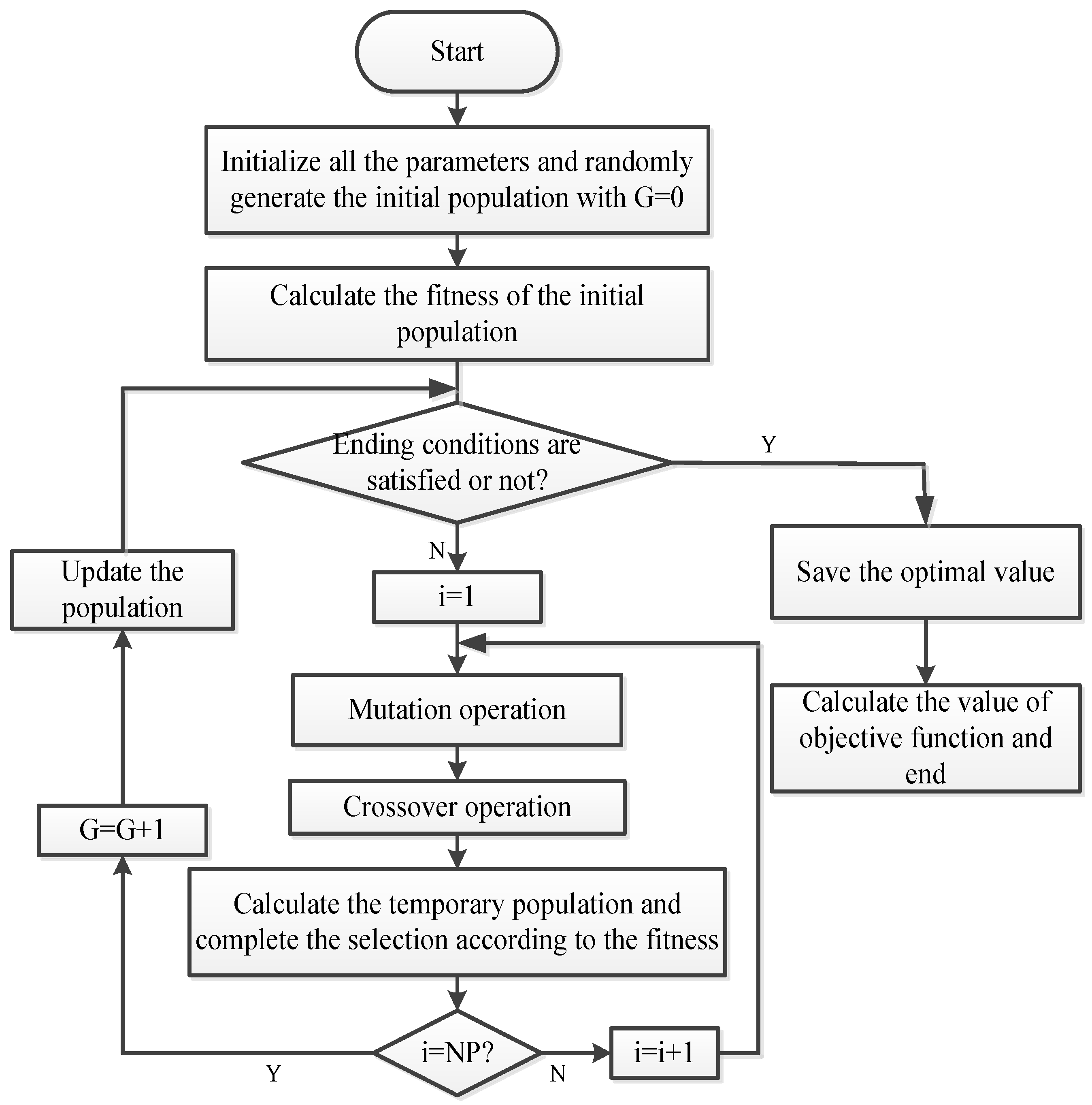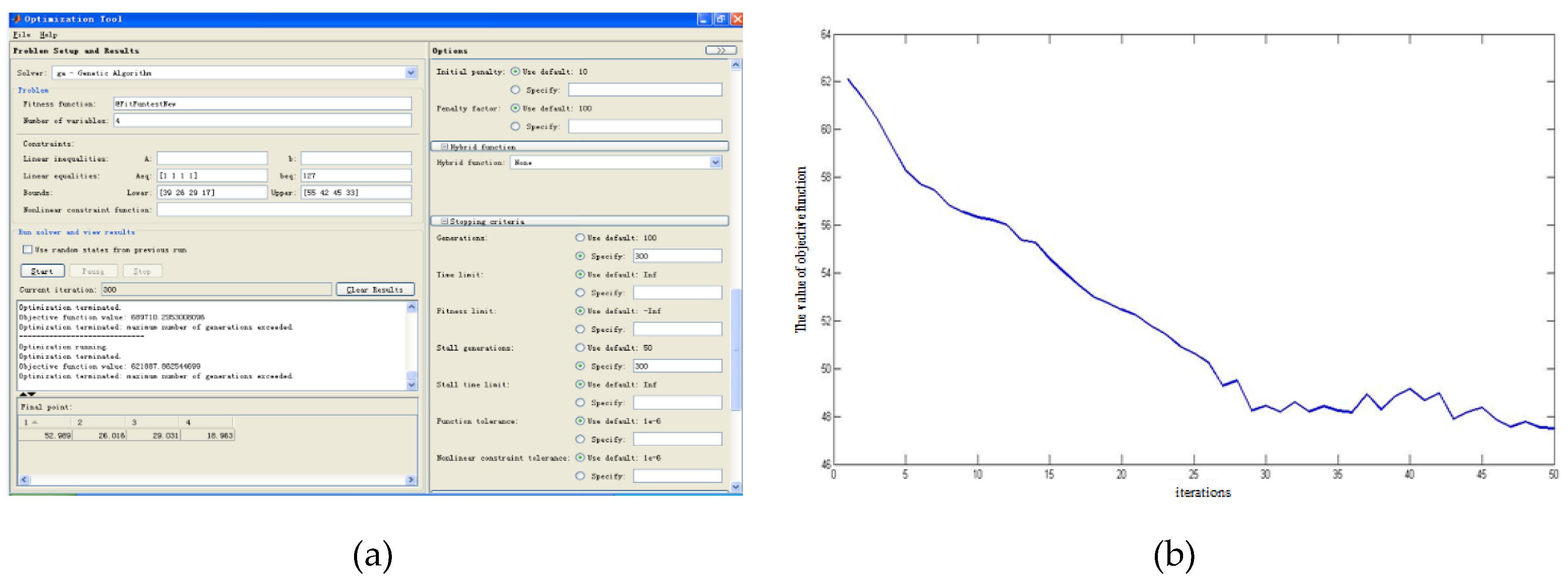Signal Timing Optimization Model Based on Bus Priority
Abstract
1. Introduction
2. Literature Review
3. The Basic Outline of Optimization Signal Timing
3.1. Assumptions and Notations
- Only two modes of traffic (bus and private car) are contained in the network and mixed traffic influence is not considered.
- The travel demand is known and remains fixed during the analysis period.
- The traffic signal control details and the intersection configuration are known.
3.2. The Objective Function of Signal Timing Optimization
3.2.1. The Representation of Total Passenger Delay
3.2.2. The representation of total vehicle delay
3.3. The Constraints of Signal Timing Optimization
3.3.1. The Constraints of Timing Optimization for Private Vehicle Lane
3.3.2. The constraints of timing optimization for bus lane
3.3.3. The Constraints of Green Time
4. Bi-Level Optimization Model of Signal Timing
4.1. The Fundamentals of Bi-Level Programming Theory
4.2. Bi-Level Model Formulation of Signal Timing Optimization
4.2.1. Upper-Level Formulation
4.2.2. Lower-Level Formulation
5. Solution Algorithm
5.1. Differential Evolution Algorithm
5.2. Application of DE Algorithm on Bi-Level Model
6. Case Study
6.1. Basic Data
6.2. The Numerical Results
6.3. Simulation and Result Discussion
- (1)
- Compared with the traditional timing model, the application of the optimization model reduces the total running delay of vehicles in lanes. The result shows that the optimization scheme can improve the overall traffic benefit by improving the traffic capacity of buses and reducing the adverse impact on private vehicles of bus-priority approaches.
- (2)
- Compared with the traditional timing model, the application of optimization model can reduce the average passenger delay at the intersection substantially. The result shows that the optimization scheme can decrease the overall traffic delay of passengers by improving the priority capacity of buses at the intersection, which reflects the people-oriented priority strategy in the optimization process.
7. Conclusions
Author Contributions
Funding
Conflicts of Interest
References
- Bagherian, M.; Mesbah, M.; Ferreira, L.; Charles, P.; Khalilikhah, M. Network-Wide Optimization of Transit Signal Priority. In Proceedings of the 94th Annual Meeting for Transport Research Board (TRB), Washington, DC, USA, 11–15 January 2015; pp. 1135–1146. [Google Scholar]
- Tien, T.L.; Graham, C.; Mark, W.; Chris, D.G.; An, K. Coordinated transit signal priority model considering stochastic bus arrival time. IEEE Trans. Intell. Transp. Syst. 2018, 20, 1–9. [Google Scholar]
- Ghanim, M.; Dion, F.; Abulebdeh, G. Integration of signal control and transit signal priority optimization in coordinated network using genetic Algorithms and artificial neural networks. Can. Geotech. J. 2009, 41, 1241–1249. [Google Scholar]
- Wang, Q.P.; Tan, X.L.; Zhang, S.R. Signal timing optimization of urban single-point intersections. J. Traffic Transp. Eng. 2006, 6, 60–64. [Google Scholar]
- Zhang, W.H.; Lu, H.P.; Shi, Q. Optimal signal-planning method of intersections based on bus priority. J. Traffic Transp. Eng. 2004, 4, 49–53. [Google Scholar]
- Liu, H.H.; Wang, X.Y.; Yang, Z.S. Control strategies of urban transit signal priority. J. Highw. Transp. Res. Dev. 2004, 21, 121–124. [Google Scholar]
- Furth, P.; Muller, T.H. Conditional bus priority at signalized intersections: Better service with less traffic disruption. Transp. Res. Rec. 2000, 1731, 23–30. [Google Scholar] [CrossRef]
- Richardson, A.J.; Ogden, K.W. Evaluation of active bus-priority signals. Transp. Res. Rec. 1979, 718, 5–12. [Google Scholar]
- Zheng, C.J.; Chen, S.Y.; Wang, W. A matter-element based approach to evaluating alternatives of priority of public transit at intersections. J. Highw. Transp. Res. Dev. 2004, 21, 98–101. [Google Scholar]
- Wu, J.; Hounsell, N. Bus priority using pre-signals. Transp. Res. Part A 1998, 32A, 563–583. [Google Scholar] [CrossRef]
- Mirchandani, P.; Knyazyan, A.; Head, L.; Wu, W. An Approach Towards the Integration of Bus Priority, Traffic Adaptive Signal Control, and Bus Information/Scheduling Systems; Springer: Berlin/Heidelberg, Germany, 2001. [Google Scholar]
- Jacobson, J.; Sheffi, Y. Analytical model of traffic delays under bus signal preemption: Theory and application. Transp. Res. Part B Methodol. 1981, 15, 127–138. [Google Scholar] [CrossRef]
- Dion, F.; Hellinga, B. A rule-based real-time traffic responsive signal control system with transit priority: Application to an isolated intersection. Transp. Res. Part B 2002, 36, 325–343. [Google Scholar] [CrossRef]
- Sun, W.T.; Wang, C.S.; Wen-Yu, M.A.; Sun, L.Y. Research on the algorithm based on bus signal priority. Railw. Transp. Econ. 2008, 30, 50–52. [Google Scholar]
- Yang, X.G.; Lin, Y.; Hang, M.S. Study of solution for transit priority signal. China J. Highw. Transp. 2001, 14, 101–108. [Google Scholar]
- Zhou, G.; Gan, A. Performance of transit signal priority with queue jumper lanes. Transp. Res. Rec. J. Transp. Res. Board. 2005, 1925, 265–271. [Google Scholar] [CrossRef]
- Liu, T.F. Research on Bus Priority Control Method under Coordinate Control. Master’s Thesis, Dalian University of Technology, Dalian, China, 2009. [Google Scholar]
- Wang, B.; Liu, X.; Li, Y.; Chen, X.; Wang, H. A Method of public traffic signal priority and verification based on coordination of trunk road. J. Highw. Transp. Res. Dev. 2011, 7, 36–39. [Google Scholar]
- Guan, W.; Shen, J.S.; Fang, G.E. Research on traffic signal control strategy for bus priority. J. Syst. Eng. 2001, 16, 176–180. [Google Scholar]
- Zhang, W.H.; Lu, H.P.; Liu, Q. Study on evaluation index system of bus priority measures. Commun. Stand. 2004, 6, 85–89. [Google Scholar]
- Salter, R.J.; Shahi, J. Prediction of effects of bus-priority schemes by using computer simualtion techniques. Transp. Res. Rec. J. Transp. Res. Board. 1979, 718, 1–5. [Google Scholar]
- Chang, J.; Collura, J.; Dion, F.; Rakha, H. Evaluation of service reliability impacts of traffic signal priority strategies for bus transit. Transp. Res. Rec. J. Transp. Res. Board. 2003, 1841, 23–31. [Google Scholar] [CrossRef]
- Khasnabis, S.; Karnati, R.; Rudraraju, R. NETSIM-based approach to evaluation of bus preemption strategies. Transp. Res. Rec. J. Transp. Res. Board. 1996, 1554, 80–89. [Google Scholar] [CrossRef]
- Labib, S.M.; Mohiuddin, H.; Hasib, I.M.A.; Sabuj, S.H.; Hira, S. Integrating data mining and microsimulation modelling to reduce traffic congestion: A case study of signalized intersections in Dhaka, Bangladesh. Urban Sci. 2019, 3, 41. [Google Scholar] [CrossRef]
- Hamilton, A.; Waterson, B.; Cherrett, T.; Robinson, A.; Snell, I. The evolution of urban traffic control: Changing policy and technology. Transp. Plan. Tech. 2013, 36, 24–43. [Google Scholar] [CrossRef]
- Webster, F.V. Traffic signal settings. Road Res. Lab. Tech. Pap. 1958, 39, 258–263. [Google Scholar]
- Storn, R.; Price, K. Differential Evolution—A simple and efficient heuristic for global optimization over continuous spaces. J. Glob. Optim. 1997, 11, 341–359. [Google Scholar] [CrossRef]
- Feng, X. Time optimal path planning based on differential evolution algorithm. J. Hainan Norm. Univ. 2005, 18, 74–77. [Google Scholar]
- Dowling, R.G.; Skabardonis, A.; Halkias, J.; Mchale, G.; Zammit, G. Guidelines for calibration of microsimulation models: Framework and applications. Transp. Res. Rec. 2004, 1876, 1–9. [Google Scholar] [CrossRef]



| Symbol | Definition |
|---|---|
| cycle length | |
| minimum cycle time | |
| maximum cycle time | |
| total loss time of phases | |
| number of phases | |
| green time of Phase | |
| green time ratio of Phase | |
| conversion factor | |
| number of private vehicle lanes | |
| number of bus lanes | |
| arrival rate of private vehicles in Phase | |
| arrival rate of buses in Phase | |
| saturate flow rate of private vehicle lane in Phase | |
| saturate flow rate of bus lane in Phase | |
| saturation of private vehicle lane in Phase | |
| saturation of bus lane in Phase | |
| flow ratio of private vehicle lane in Phase | |
| flow ratio of bus lane in Phase | |
| average passenger capacity of private vehicle in Phase | |
| average passenger capacity of bus in Phase | |
| the biggest flow ratio of private vehicle lane in Phase | |
| the biggest flow ratio of bus lane in Phase | |
| average delay of every private vehicle in Phase | |
| average delay of every bus in Phase | |
| total passenger delay of private vehicles in one cycle | |
| total passenger delay of buses in one cycle | |
| total vehicle delay in private vehicle lane | |
| total vehicle delay in bus lane | |
| total passenger delay in one cycle | |
| average running delay of all vehicles | |
| average passenger delay | |
| width of intersection | |
| average walk speed to cross the intersection | |
| compensation coefficient |
| Variables | |||||||
| Results | 41 | 21 | 24 | 17 | 0.360 | 0.184 | 0.211 |
| Variables | |||||||
| Results | 0.149 | 0.731 | 0.859 | 0.839 | 0.718 | 0.750 |
| Traffic Behavior | Parameters | Default Value | Modified Value |
|---|---|---|---|
| Car following | Average stand still | 2.00(m) | 1.50(m) |
| Additive part of safety | 2.00 | 1.50 | |
| Multiplication part of safety | 3.00 | 2.50 | |
| Lane changing | General Behavior | Free lane selection | Free lane selection |
| Lateral change | Desired Position | Middle of lane | Middle of lane |
| Consider next turn direction | Not marked | Marked | |
| Overtake on same lane | Not marked | Marked (Left) | |
| Signal Control | Decision-making model | Continuous inspection | Continuous inspection |
| Reduction factor | 0.60 | 0.70 | |
| Mesoscopic | Reaction time | 1.20(s) | 1.30(s) |
| Direction | Observed Data | Simulated Results | GEH Value | Error of Delay | Error of Queue Length | ||||
|---|---|---|---|---|---|---|---|---|---|
| Traffic Volume (pcu/h) | Delay (s) | Queue Length (m) | Traffic Volume (pcu/h) | Delay (s) | Queue Length (m) | ||||
| West | 840 | 37.4 | 78 | 930 | 39.8 | 81 | 3.03 | 6.42% | 3.85% |
| East | 565 | 26.1 | 60 | 525 | 24.6 | 58 | 1.71 | −5.75% | −3.33% |
| North | 504 | 19.7 | 54 | 565 | 20.8 | 56 | 2.64 | 5.58% | 3.70% |
| South | 384 | 24.3 | 42 | 455 | 25.5 | 40 | 3.47 | 4.94% | −4.76% |
| Index | Evaluated Objects and Content |
|---|---|
| Travel time | Average travel time of buses |
| Average travel time of private vehicles | |
| Delay | Average running delay of vehicles |
| Average passenger delay at the intersection |
| Timing Scheme | Average Travel Time of Buses[s] | Average Travel Time of Private Vehicles[s] | Average Running Delay of Vehicles[s] | Average Passenger Delay at the Intersection[s] |
|---|---|---|---|---|
| Timing scheme of traditional model | 56.01 | 53.57 | 49.85 | 46.29 |
| Timing scheme of optimal model | 53.18 | 55.99 | 47.53 | 41.01 |
| Ratio enhancement | −5.1% | +4.5% | −4.6% | −11.4% |
© 2020 by the authors. Licensee MDPI, Basel, Switzerland. This article is an open access article distributed under the terms and conditions of the Creative Commons Attribution (CC BY) license (http://creativecommons.org/licenses/by/4.0/).
Share and Cite
Sun, X.; Lin, K.; Jiao, P.; Lu, H. Signal Timing Optimization Model Based on Bus Priority. Information 2020, 11, 325. https://doi.org/10.3390/info11060325
Sun X, Lin K, Jiao P, Lu H. Signal Timing Optimization Model Based on Bus Priority. Information. 2020; 11(6):325. https://doi.org/10.3390/info11060325
Chicago/Turabian StyleSun, Xu, Kun Lin, Pengpeng Jiao, and Huapu Lu. 2020. "Signal Timing Optimization Model Based on Bus Priority" Information 11, no. 6: 325. https://doi.org/10.3390/info11060325
APA StyleSun, X., Lin, K., Jiao, P., & Lu, H. (2020). Signal Timing Optimization Model Based on Bus Priority. Information, 11(6), 325. https://doi.org/10.3390/info11060325





